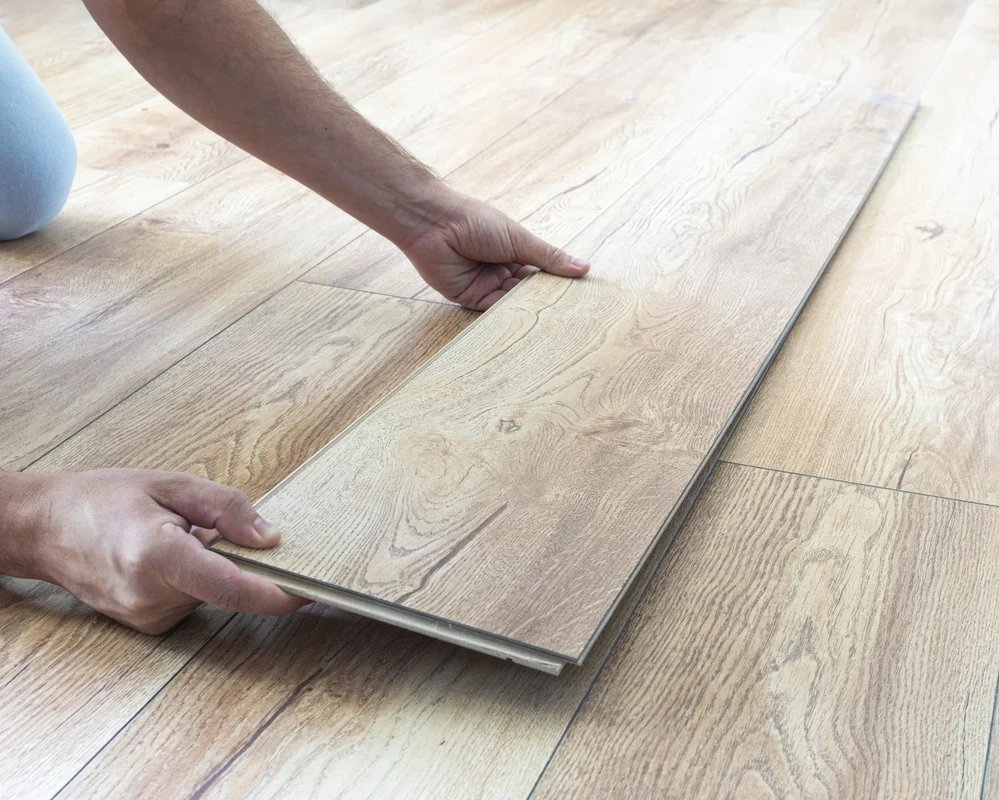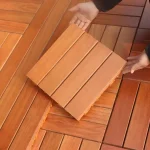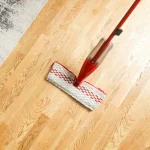- October 20, 2024
Laminate flooring offers an attractive and practical solution for many homes. However, it’s not without its challenges. One common issue homeowners encounter is laminate flooring lifting. It occurs when the planks start to separate or rise from the subfloor. It affects the aesthetics and can lead to further damage if not addressed promptly. Several factors can contribute to this problem.
Moisture damage is a primary cause of laminate flooring issues. Excessive water can seep into the laminate, causing it to swell and buckle. Uneven subfloors can also be problematic. If the underlying surface isn’t level, it creates pressure points. These pressure points disrupt the laminate’s even surface.
Also, a lack of proper expansion gaps around the perimeter of the flooring can lead to problems. Without these gaps, the laminate may expand and contract unevenly. It can result in lifting.
Understanding these causes is essential for effectively addressing the issue. Identifying the underlying problem is essential. It will guide you in choosing the appropriate repair methods to restore the integrity and appearance of your laminate flooring.
Causes of Laminate Flooring Lifting
Understanding the causes of laminate flooring lifting is crucial. It helps maintain both the look and functionality of your floor.
- One major culprit is moisture damage. Laminate flooring is sensitive to excess water. Water can seep into the planks and cause them to swell and buckle. This is particularly problematic in areas prone to spills or high humidity. Examples include bathrooms and kitchens.
- Another common cause of lifting is improper installation. Laminate floors require precise installation techniques. It includes leaving adequate expansion gaps around the edges. It also involves ensuring that the planks are aligned correctly. Failing to follow these guidelines can lead to issues. The flooring may not perform as expected. It can result in gaps and lifting.
- Uneven subfloors also play a significant role in laminate flooring problems. A subfloor that isn’t level can create pressure points. These pressure points disrupt the smooth surface of the laminate. Imperfections in the subfloor can also contribute to this problem. Over time, these pressure points can cause the flooring to lift and become uneven.
You can better manage and prevent lifting by addressing these causes—moisture damage, improper installation, and uneven subfloors.
Signs Your Laminate Floor Is Lifting
Recognizing the signs of laminate flooring lifting early is important. It helps you address the problem before it worsens. There are several key indicators that your laminate floor may be lifting.
- One noticeable sign is buckling or separation between the planks. It occurs when the laminate starts to warp. It creates gaps between the planks. These gaps disrupt the smooth, seamless appearance of your floor.
- Another telltale sign is gaps forming between the floor and baseboard. These gaps often result from the laminate expanding. The expansion pushes against the walls. It causes the laminate to lift and create noticeable spaces.
- Surface unevenness when walking across the floor is another significant indicator. It signals that the laminate may be lifting. If you feel unevenness or notice areas of the floor that seem to have risen or sunk, it’s a sign that something is wrong. Various issues can cause it. These include moisture damage, improper installation, or an uneven subfloor.
Detecting these signs early is crucial for timely intervention. Addressing the underlying causes of lifting can prevent further damage. Keep an eye out for these symptoms. It will help you maintain the integrity of your floor.
Preparation Before Repair
Proper preparation is essential before starting the process of repairing a laminate floor that is lifting. Taking the right steps can help ensure a successful and lasting repair. The first step is to clear and clean the affected area. Removing furniture, rugs, and any other obstacles will give you full access to the section of the floor that needs attention. Remove dust and debris, as they can interfere with the repair process.
Next, inspect the floor for moisture or subfloor damage. Moisture is a common cause of laminate lifting, and it’s crucial to check if water has seeped under the flooring. If you detect moisture, address the source before repairs begin. Likewise, inspect the subfloor for any unevenness or damage, as this can also lead to lifting. If the subfloor is the issue, it may need to be leveled or repaired before reinstalling the laminate.
Finally, gather the necessary tools and materials for the repair. Depending on the cause of the lifting, you may need several tools. Pry bars can help remove damaged planks. You may also need new laminate planks to replace old ones. Additionally, adhesives and leveling compounds might be required. Having these tools ready will make the repair process smoother and more efficient.
Moisture Damage Repair
Repairing moisture-damaged laminate flooring involves a few key steps.
- First, you’ll need to remove the damaged planks. Carefully lift the affected planks with a pry bar or similar tool. Be cautious to avoid causing damage to the surrounding area.
- Once you removed the damaged pieces, inspect the subfloor for any signs of moisture.
- Dry the area thoroughly, as leaving moisture behind can lead to recurring issues.
- After the area is completely dry, you can begin installing new planks. Make sure the replacement planks match the floor in design and thickness. Use the appropriate adhesive or click-lock mechanism, depending on the type of laminate flooring you have, to secure the new planks in place.
- It’s important to take precautions to avoid future moisture problems. One key step is to install a waterproof underlayment beneath the laminate. This barrier helps protect against moisture seeping through from the subfloor.
- Additionally, address any sources of water, such as leaks or high humidity.
You can restore your laminate flooring by following these steps and taking preventive measures. It will reduce the risk of future moisture-related lifting. Proper moisture management is essential. It helps maintain the longevity and appearance of your laminate floors.
Uneven Subfloor Repair
Uneven subfloors are a common cause of laminate flooring lifting. Repairing the subfloor is essential to ensure the laminate remains stable and smooth. Whether you have a concrete or plywood subfloor, the process starts the same. Begin by identifying the uneven areas.
For concrete subfloors, use a leveling compound to fill in low spots and create a smooth surface. It involves cleaning the area, applying the compound, and allowing it to cure. For plywood subfloors, you can sand down high areas. Alternatively, adding shims to low areas can help achieve a level surface.
Once the subfloor is even, it’s important to reinstall the laminate flooring properly. Before doing so, double-check that the subfloor is dry and smooth. Next, reinstall the laminate planks. Make sure to leave adequate expansion gaps around the edges. It helps prevent future lifting. Depending on the type of laminate, you may need to use an adhesive or a click-lock mechanism to secure the planks.
Leveling the subfloor fixes the immediate lifting problem. It also prevents the issue from recurring. Properly addressing an uneven subfloor ensures the laminate flooring remains stable. It provides a smooth and even surface for years to come.
Expansion Gap Adjustment
Expansion gaps are crucial for maintaining the integrity of laminate flooring. These gaps allow the laminate to expand and contract with changes in temperature and humidity. It prevents issues like lifting. If your laminate flooring is lifting, adjusting the expansion gaps may be necessary.
First, you’ll need to cut or adjust the existing expansion gaps. Use tools like a circular saw to trim the laminate around the edges of the room. Be careful to ensure there’s enough space for expansion. This process requires precision to avoid damaging the laminate or the subfloor.
Once the expansion gaps are adjusted, reinstall the baseboards or trim around the edges of the floor. Ensure that the baseboards are properly secured. Also, make sure there is still sufficient space for the laminate to expand and contract.
Finally, check other potential problem areas in the flooring. Ensure that there are no other issues affecting the floor. Check for moisture damage or uneven subfloors. These problems can contribute to the lifting.
Preventing Laminate Flooring from Lifting in the Future
Preventing laminate flooring from lifting in the future involves several key factors. These include proper installation practices and moisture management. They also involve subfloor preparation and maintaining adequate expansion gaps. Each factor plays a crucial role. They all contribute to ensuring the long-term stability of your laminate flooring. They also help maintain its appearance.
Proper installation is essential for preventing lifting. It is vital to follow the manufacturer’s installation instructions carefully. It includes the correct laying technique and the use of recommended materials. Deviating from these guidelines can lead to problems. These include misalignment and insufficient expansion space.
Moisture management is another key aspect. Using vapor barriers protects the laminate from moisture seeping up from the subfloor. Additionally, controlling indoor humidity levels helps prevent excessive expansion and contraction.
The subfloor must be level and clean before installing laminate flooring. An uneven subfloor can create pressure points. These pressure points disrupt the laminate’s smooth surface. A dirty subfloor can also cause similar issues.
Expansion gaps are also critical. During installation, make sure to leave adequate gaps around the edges of the room. These gaps allow the laminate to expand and contract. It occurs with changes in temperature and humidity. The gaps prevent lifting.
FAQs
– Can laminate flooring be reinstalled after lifting?
Yes, laminate flooring can be reinstalled after lifting. First, address the underlying issue, such as moisture or subfloor problems. Then, remove and replace any damaged planks. Ensure proper expansion gaps and subfloor conditions before reinstalling. It will help prevent future lifting and maintain the floor’s stability.
– What humidity level is best for laminate flooring?
The ideal humidity level for laminate flooring is between 30% and 50%. Maintaining this range helps prevent issues like expansion, contraction, and lifting. Use a dehumidifier or humidifier to control indoor humidity levels. It helps ensure the laminate remains stable and durable.
– How do you prevent water damage under laminate flooring?
Use a vapor barrier or a moisture-resistant underlayment to prevent water damage under laminate flooring. Address any leaks or sources of moisture promptly. Maintain proper indoor humidity levels. Ensure the flooring is installed with adequate expansion gaps. Regularly inspect for signs of water damage to address issues early.
Conclusion
Fixing laminate flooring that is lifting requires a comprehensive approach. Start by identifying the underlying cause. It can be moisture damage, improper installation, or an uneven subfloor. Remove and replace any damaged planks. Ensure the subfloor is level and adjust expansion gaps as needed. Proper installation practices and moisture management are crucial.
Maintaining adequate expansion gaps is also important to prevent future lifting. By addressing these factors thoroughly, you can restore the appearance and stability of your laminate flooring. It will help ensure it remains functional and attractive for years to come. Regular maintenance and timely repairs will help keep your floor in excellent condition.




